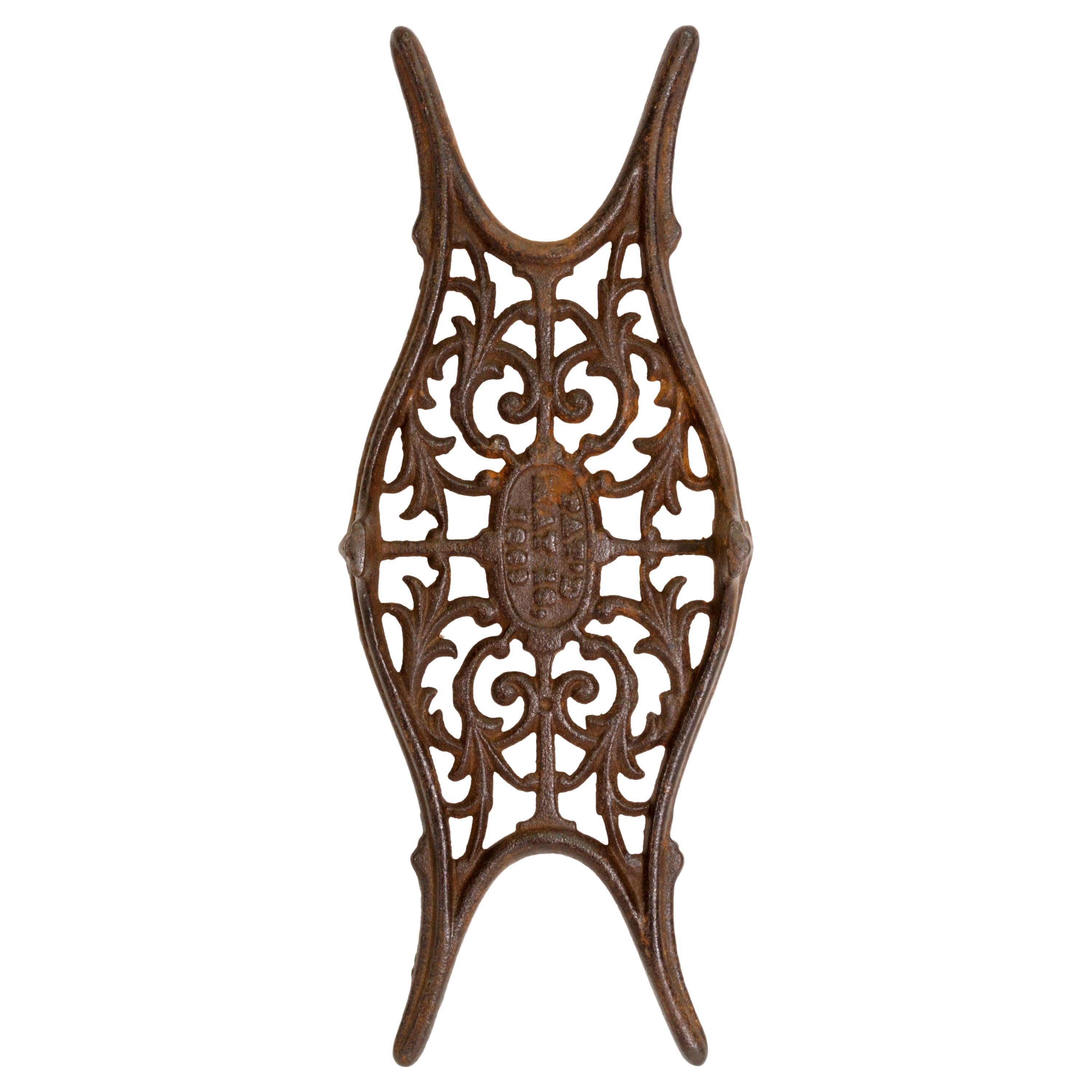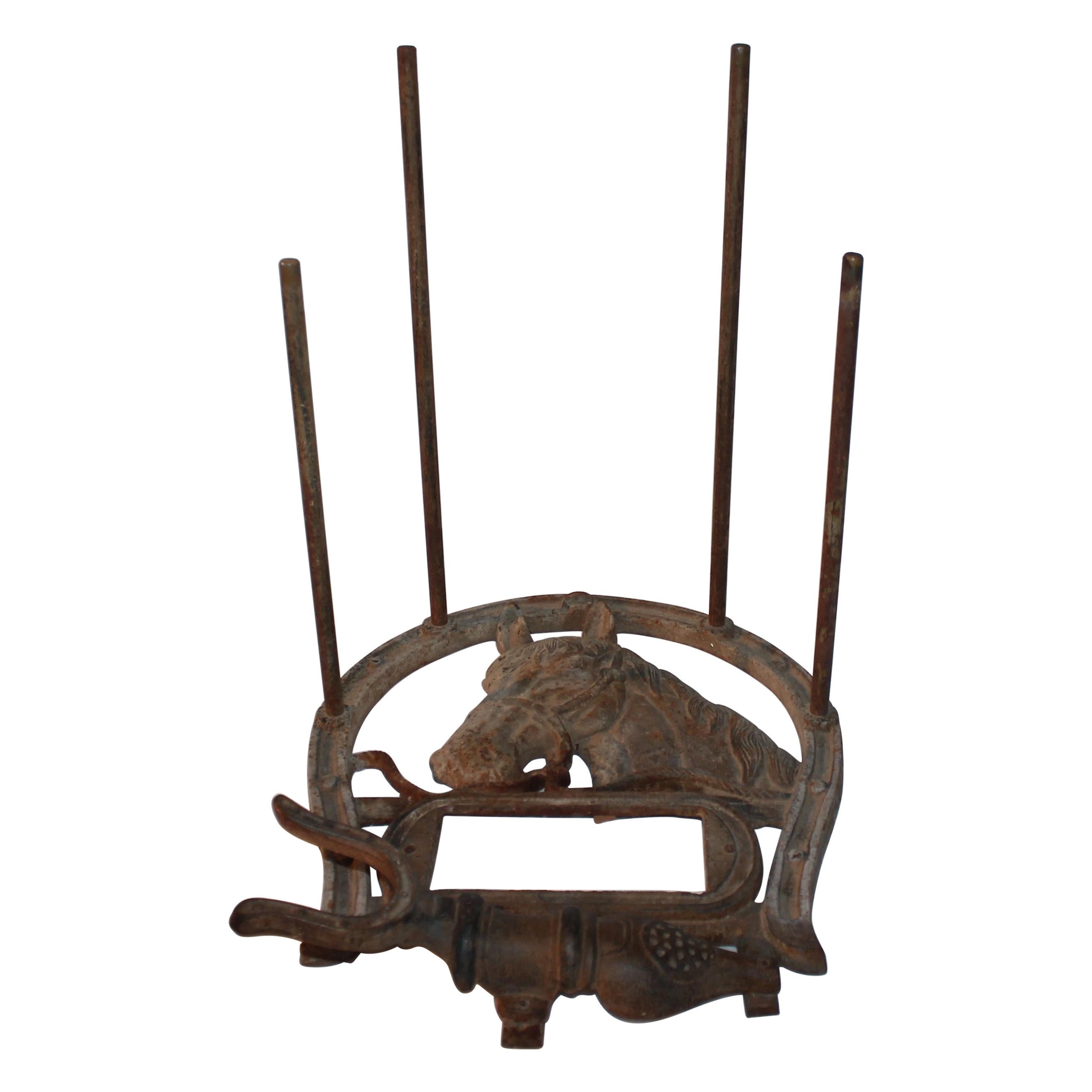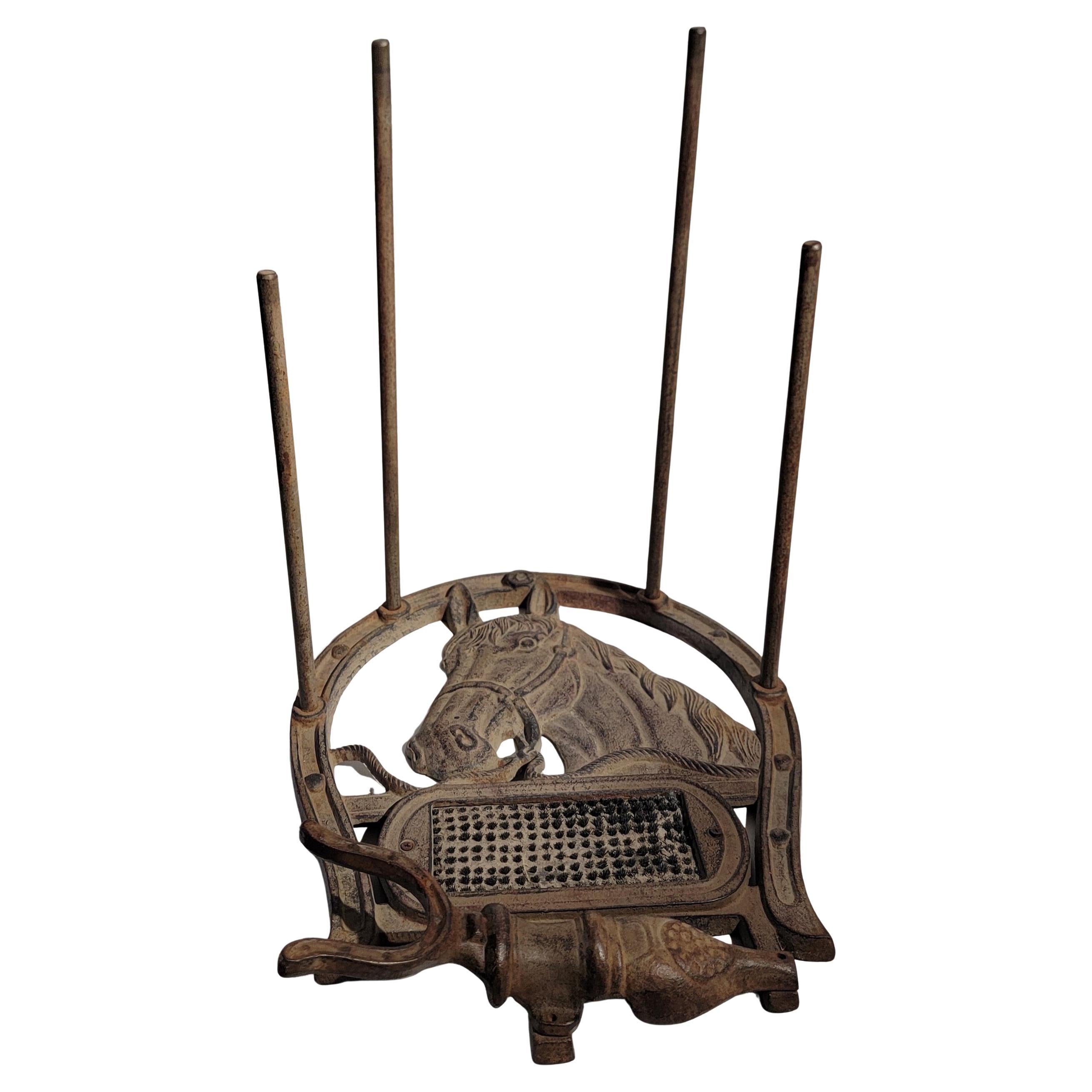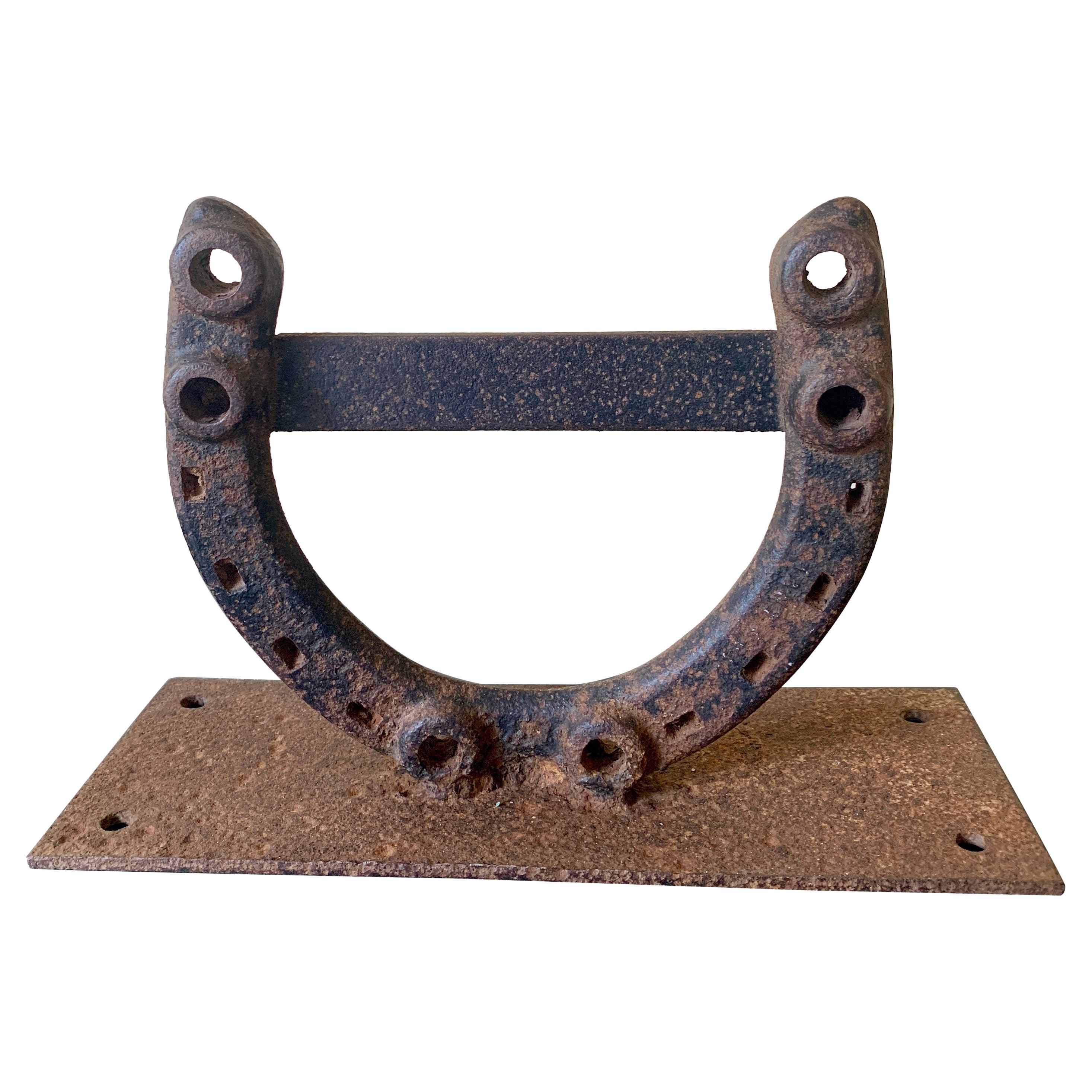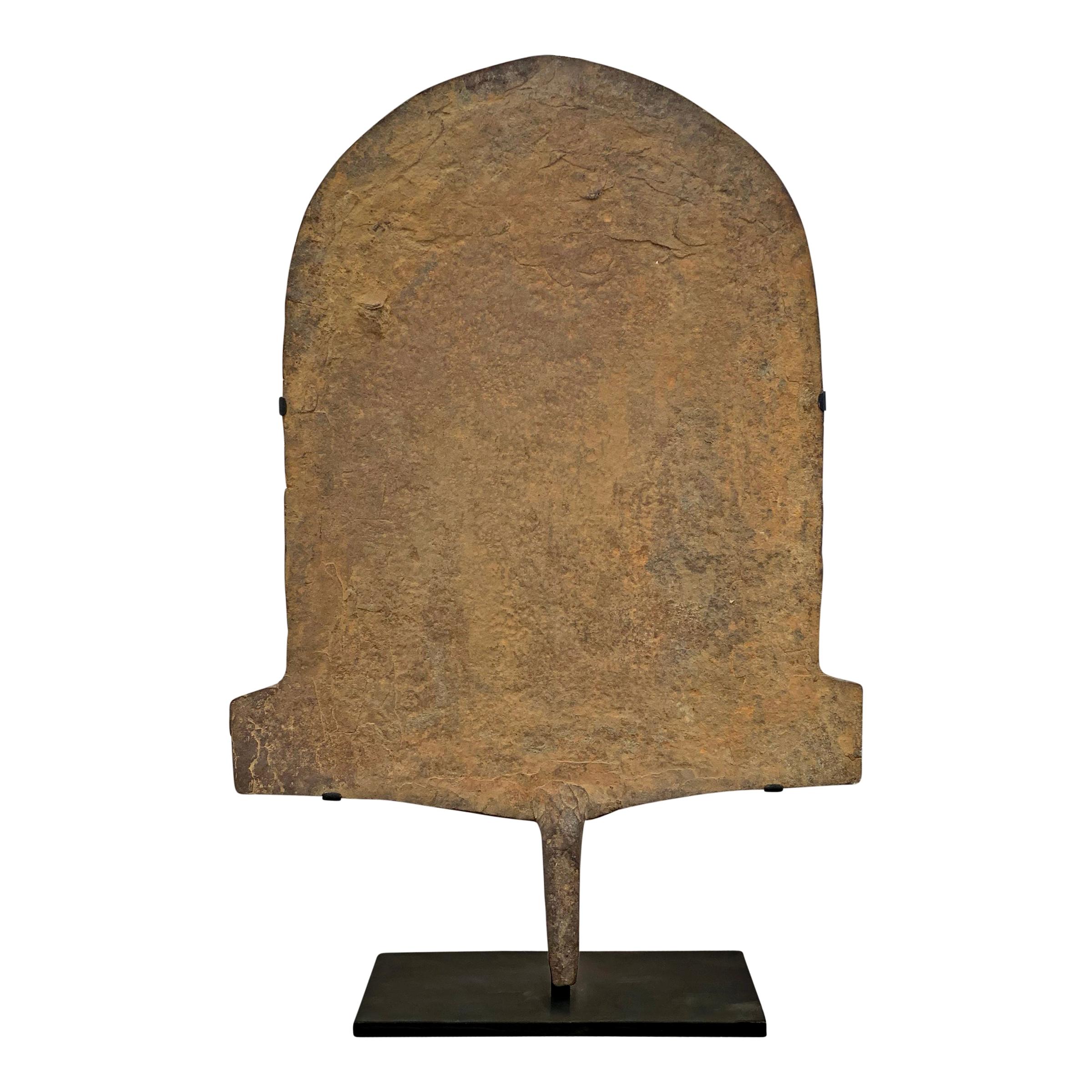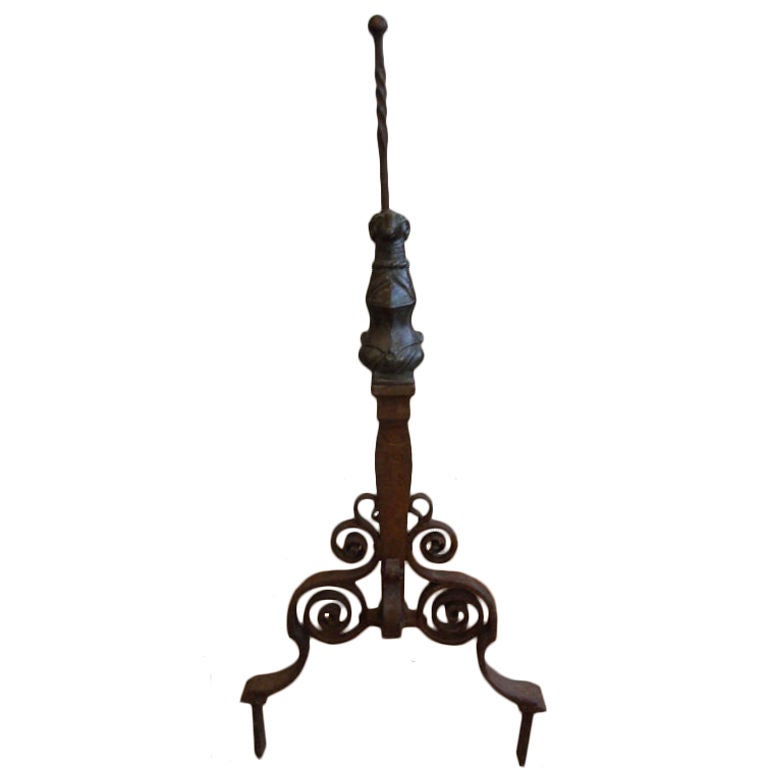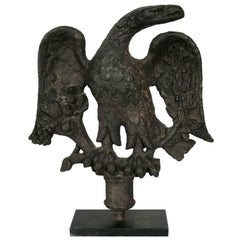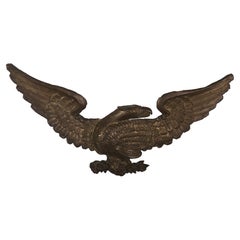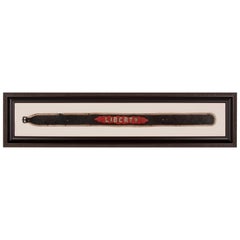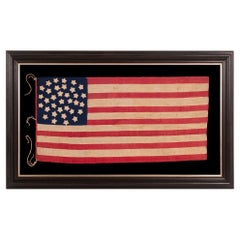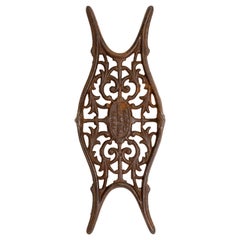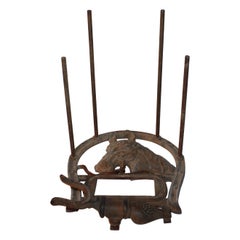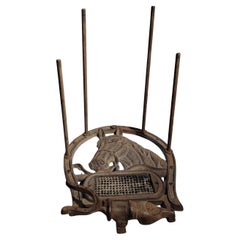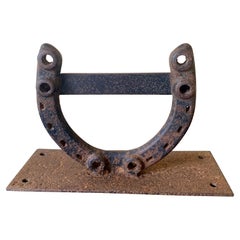Items Similar to Cast Iron Boot Jack Made for 1864 Presidential Campaign of George McClellan
Want more images or videos?
Request additional images or videos from the seller
1 of 5
Cast Iron Boot Jack Made for 1864 Presidential Campaign of George McClellan
$6,800
£5,159.68
€5,899.64
CA$9,497.76
A$10,560.21
CHF 5,513.96
MX$128,543.50
NOK 70,355.73
SEK 65,919.96
DKK 44,030.07
Shipping
Retrieving quote...The 1stDibs Promise:
Authenticity Guarantee,
Money-Back Guarantee,
24-Hour Cancellation
About the Item
CAST IRON BOOT JACK, MADE FOR THE 1864 PRESIDENTIAL CAMPAIGN OF GENERAL GEORGE B. MC CLELLAN, WITH A FANTASTIC SLOGAN THAT READS "THE UNION AT ALL HAZZARDS"
Made for the 1864 presidential run of George B. McClellan, this cast iron bootjack is both rare and graphically exceptional. Displaying the original black-painted surface, with attractive and desirable patina, the stylized profile has a wonderful folk art quality. Molded block letters that wrap around the heel clasp read simply "Gen. Mc Clellan. These are accompanied by a prominent Civil War-associated slogan: "The Union at all Hazards." The text is intermingled with 34 stars, which was equivalent to the number of states during the opening two years of the war, but was one star short by mid-1863 and two stars short by the time of the actual election in 1864. It's not unusual to encounter this feature in civil war campaign parade flags as well as all manner of flag-related ephemera.
The iron was reportedly cast by G. & D. Cross of Morrisville, New York, though it is unsigned and I have not yet verified the attribution. I have seen two other examples, one of which had a broken and repaired tine on the U-shaped horns and newly painted surface, while the other appeared to have broken lifters and inferior, rusted patina. This is, hands-down, the best of the identified examples.
Brief History of the 1864 Campaign:
President Abraham Lincoln had a checkered relationship with his 1864 opponent, who he had formerly chosen as General-in-Chief of the entire Union Army. The career officer repeatedly knocked heads with his Commander-in-Chief. Having raised a well-trained and organized military force, McClellan often seemed reluctant to use it. By 1862, after losses in Virginia during the Peninsula Campaign, Lincoln grew frustrated with McClellan and the progression of the war and removed him from command.
By the early part of 1864 the American people shared some of the same frustrations and Lincoln was no longer the clear choice for the White House. The nation was tired of war and the remains of the Democratic Party were calling for peace. At their convention in Chicago, they nominated General McClellan to champion their platform alongside career politician George H. Pendleton.
Without its southern base of support, the Democratic Party was split in 1864 among “War Democrats,” “Peace Democrats,” and “Copperheads.” The War Democrats joined the Republicans to form the "National Union Party, " while the Copperheads never gained much strength due to blatant sympathies for the Confederate cause. The remaining "Peace Democrats" backed McClellan, but the general, who carried wide support among soldiers and remained on active duty until election day, openly disagreed with the desire for a negotiated settlement with the South. This caused further party divisions, which, compounded by significant Union victories, led to his defeat.
Mounting: The object was mounted in a deep shadow box that consists of a black-painted, rectangular outer molding with a wood grain surface, to which a flat profile molding with a gilded surface was added as a liner. The background is 100% hemp fabric. The glazing is U.V. protective museum glass (anti-reflective and crystal clear).
Condition: Minor, expected wear.
- Dimensions:Height: 18.5 in (46.99 cm)Width: 10.5 in (26.67 cm)Depth: 4 in (10.16 cm)
- Materials and Techniques:
- Place of Origin:
- Period:
- Date of Manufacture:1864
- Condition:See Item Description.
- Seller Location:York County, PA
- Reference Number:Seller: pat-5211stDibs: LU849731372852
About the Seller
5.0
Recognized Seller
These prestigious sellers are industry leaders and represent the highest echelon for item quality and design.
Established in 1991
1stDibs seller since 2008
70 sales on 1stDibs
Typical response time: 1 to 2 days
- ShippingRetrieving quote...Shipping from: York County, PA
- Return Policy
Authenticity Guarantee
In the unlikely event there’s an issue with an item’s authenticity, contact us within 1 year for a full refund. DetailsMoney-Back Guarantee
If your item is not as described, is damaged in transit, or does not arrive, contact us within 7 days for a full refund. Details24-Hour Cancellation
You have a 24-hour grace period in which to reconsider your purchase, with no questions asked.Vetted Professional Sellers
Our world-class sellers must adhere to strict standards for service and quality, maintaining the integrity of our listings.Price-Match Guarantee
If you find that a seller listed the same item for a lower price elsewhere, we’ll match it.Trusted Global Delivery
Our best-in-class carrier network provides specialized shipping options worldwide, including custom delivery.More From This Seller
View AllAmerican Federal Period Cast Iron Eagle
Located in York County, PA
This cast iron eagle is one of the earliest sculptural forms that one will encounter in the marketplace. It is also one of the most attractive and ico...
Category
Antique 1810s American Political and Patriotic Memorabilia
Materials
Iron
Pressed Brass Eagle, Parade Flag Holder and Bunting Tie Back, ca 1880-1895
Located in York County, PA
Pressed brass eagle, an early parade flag holder & bunting tie-back, an especially attractive example, circa 1880-1895
Pressed brass eagles decorated the interiors of Civil War ve...
Category
Antique Late 19th Century American Political and Patriotic Memorabilia
Materials
Brass
Leather Fireman's Parade Belt
Located in York County, PA
Leather fireman's parade belt with the word "LIBERTY in white on a red ground, Bloomsburg, Pennsylvania, circa 1900
This fireman's parade belt is of the type produced during the latter part of the 19th century, between roughly 1870 and 1900. Made of leather, the body of the belt is black. In the center is a recessed window, with a fancifully scalloped edge, behind which a red leather panel, upon which the word "Liberty" appears in raised, white letters. There is a white binding, it's edge trimmed with pinking shears to create a decorative border. The metal buckle fits into an opposing leather strap, small in scale and riveted beneath the outer one.
The words that appear on fireman's parade belts were customized, sometimes displaying the title of the wearer (i.e., "chief" or "clerk"), sometimes the name of the city or town, and sometimes the name of the station, as-is the case in this instance.
Attributed to Bloomsburg, Pennsylvania (Columbia County), I acquired it about 25 miles southwest, in adjacent Union County. Bloomsburg's first fire house, Friendship Fire Company, was established in 1868, shortly following the Civil War. Like most volunteer departments of that time, it was staffed by returning Union soldiers who volunteered, enjoying the comradery. Three more would follow, including Rescue Hose & Ladder (1870), Winona (1881), and Liberty Fire Company (1900). In the early 1990's the process was begun to modernize and consolidate all four stations into one. Liberty's fire house still stands on the 100 block of Leonard Street.
Probably made in the year the Liberty Fire Company was established, for related parades and festivities, the great thing about this belt is the combination of the wonderful, early, painted surface and the terrific verbiage. While words such as "Clerk," "Bloomsburg," or "Rescue" would have limited appeal, the word "Liberty" opens the playing field to a nation-wide audience. Fire memorabilia...
Category
Antique Early 1900s American Political and Patriotic Memorabilia
Materials
Leather
34 STAR AMERICAN FLAG, CIVIL WAR, 1861-63, KANSAS STATEHOOD, 2nd KY CAVALRY
Located in York County, PA
34 STAR ANTIQUE AMERICAN FLAG OF THE CIVIL WAR PERIOD (1861-63), IN A TINY SCALE AMONG PIECED-AND-SEWN FLAGS OF THE PERIOD, WITH A TRIPLE-WREATH CONFIGURATION, AN ELONGATED FORMAT, AND ENTIRELY HAND-SEWN; FOUND WITH A LETTER FROM JOHN W. RUDE OF THE 2ND KENTUCKY VETERAN VOLUNTEER CAVALRY (UNION):
34 star flag of the Civil War period with a variety of extremely desirable features, handed down with a letter written by John W. Rude on November 8th, 1864, while encamped with the Army’s 1st Brigade, 3rd Division, as a member of the 2nd Regiment of Veteran Volunteer Cavalry. Tiny in scale among pieced and sewn examples, the flag displays a star pattern that consists of a three consecutive wreaths, with a single star in the very center. Because it lacks a single star in each corner, outside the basic pattern—usually present in flags of this design made during the mid-late 19th century—this is something I classify as a “snowball medallion.” Entirely hand-sewn throughout, note the square format of the blue canton, with its beautiful, circular star arrangement, and how interesting this combination is when paired with the elongated format of the flag itself. The stars are double-appliqued, meaning that they are applied to both sides. These are fat in shape and inconsistent in size. Note how the lowest star in the outermost ring actually dips into the white stripe below.
Made of plain weave cotton, there is a narrow binding along the hoist, red in color, with three sets of cotton ties. Those at the top and bottom are made of fine, braided hemp or hemp and cotton cord, stitched into place, while the one in the center, looped around the binding and tied, is made of lightweight, twisted, cotton thread. Note how the 5th, 6th, and 7th red stripes are pieced from two lengths of cotton fabric, which reflects that the maker was being conscious of conserving available fabric.
In the 19th century, most flags with pieced and sewn construction were 8 feet long and larger. A six-footer was considered small. Even military battle flags, carried on foot, measured 6’ x 6.5’, which translates into approximately 7’ x 7.5’ after framing, about the size of an average quilt and larger than can comfortably fit on a wall in a house with 8-foot ceilings and average width baseboard. Flags smaller than this exist, but the smaller they get, the more unusual they are. At just 1.5’ x 3’, this is about as small as one will ever encounter in a sewn flag of the Civil War era.
The flag appears to have likely been hand-carried. I expect that it probably saw military use of some sort as a camp flag...
Category
Antique 1860s American Political and Patriotic Memorabilia
Materials
Cotton
13 Star Antique American Flag, Inscribed "Spenge" ca 1895-1926
Located in York County, PA
13 STAR ANTIQUE AMERICAN FLAG WITH A 3-2-3-2-3 CONFIGURATION OF STARS ON AN ATTRACTIVE, INDIGO BLUE CANTON; A SMALL-SCALE EXAMPLE OF THE 1895-1926 ERA, INSCRIBED WITH THE SURNAME “SP...
Category
Antique Late 19th Century American Political and Patriotic Memorabilia
Materials
Wool
Commission Pennant with 13 Stars, like for Private Vessel, Ca 1892-1910
Located in York County, PA
Commission pennants are the distinguishing mark of a commissioned U.S. Navy ship. Flown at the topmast, the typical American format is a long blue field, usually with a single row of white stars, although sometimes with their total divided into two rows, followed by two long stripes, red-over-white. A ship became commissioned when this pennant was hoisted. Flown during both times of peace and war, the only time the pennant is not flown is if a flag officer or civilian official was aboard and replaced it with their own flag.
Sometimes the owners of private ships mimicked the use of Navy signals. Some seafaring men would have served in the Navy and become privy to various practices in that capacity. Others flew them purely for stylistic reasons, either on a regular basis or while the boat was dressed for special occasion. Hudson River steamers regularly flew pennants of this nature, as evidenced by period photography as well as the paintings of artists such as John and James Bard...
Category
Antique Late 19th Century American Political and Patriotic Memorabilia
Materials
Wool
Price Upon Request
You May Also Like
19th Century Brown Brothers Cast Iron Boot Jack
By Brown Brothers
Located in Coeur d'Alene, ID
19th century cast iron boot jack, with jacks on both ends and legs on both sides. Brown Brothers Foundry, patented May 18, 1869. 12" x 5". Collector's p...
Category
Antique 1860s American Antiquities
Materials
Iron
Folky Early 20thc Iron Boot Jack & Rack
Located in Los Angeles, CA
This is a fantastic cast iron boot jack has a horse embossed and pegs for the boots. The condition is very good.
Category
Early 20th Century American Adirondack More Folk Art
Materials
Iron
20Thc Horse Head Boot Jack & Boot Holder
Located in Los Angeles, CA
Early 20Thc Horse head boot jack with brush for boots.It also has spikes for hanging boots on the wall.
Category
Mid-20th Century American Adirondack Antiquities
Materials
Metal, Iron
Antique Wrought Iron Equestrian Horseshoe Boot Scrape, Early 20th Century
Located in Elkhart, IN
A beautiful rustic, farmhouse equestrian antique cast iron horseshoe boot scrape perfect for your country house, ranch, or stables.
USA, Early 20th Century
Measuers: 12"W x 4.5"D x...
Category
Early 20th Century American Country Mounted Objects
Materials
Wrought Iron
$716 Sale Price
20% Off
Mounted 19th Century Afo Iron Currency
Located in Chicago, IL
A fantastic 19th century Afo culture wrought iron spade currency piece mounted on custom steel stand. Currency pieces like these were used for large purchases including land or lives...
Category
Antique 19th Century Nigerian Tribal Mounted Objects
Materials
Iron
$4,350 Sale Price
25% Off
Iron Boot Scraper with Ram's Head Finial
Located in Greenwich, CT
A generous iron boot scrape with twisted shaft handle and bronze finial of a ram's head mounted on a heraldic helmet. Decorative scrolled base imprinted with "1928". In the manner...
Category
Early 20th Century English Folk Art Sculptures
Materials
Iron, Bronze
More Ways To Browse
Antique Jacks
Cast Iron Mold
Black Southern Folk Art
American Folk Art Wood House
Antique Hemp
Union Jack Flag
Folk Art Soldier
Antique Cast Iron Mold
Virginia House Furniture
Antique Military Memorabilia
Confederate Art
American Folk Art Cast Iron
Train Memorabilia
Civil War Memorabillia
Civil War Flags
Political Campaign Memorabilia
Antique Union Jack
Tine Box
